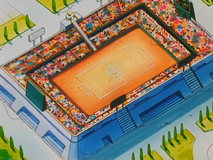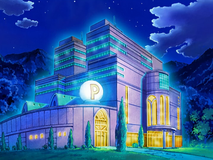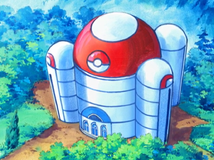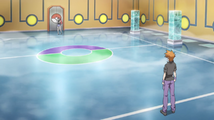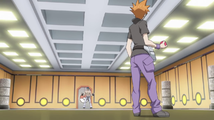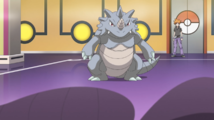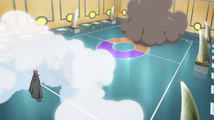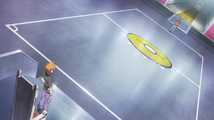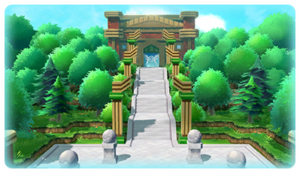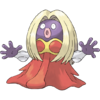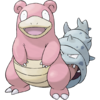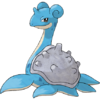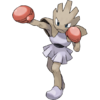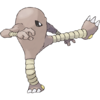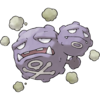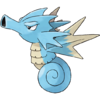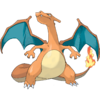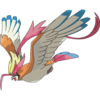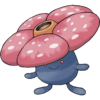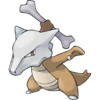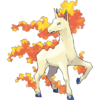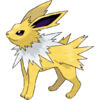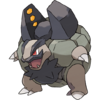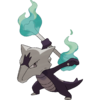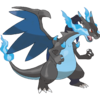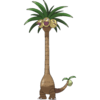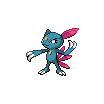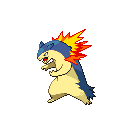- If you were looking for the chapter in Pokémon Zensho, see PZ10.
| Indigo Plateau
|
セキエイこうげん
Sekiei Plateau
|
| "The Ultimate Goal of Trainers!"
|
|
|
|

Indigo Plateau in {{{variable2}}}.
|
|
Map description
| The fate of many Trainers aiming for the top rests here.
|
|
|
[[|Indigo Plateau Gym]] - Kanto Gym #{{{gymno}}}
[[File:{{{leadersprite}}}|{{{leader}}}|link={{{leader}}}]]
[[{{{leader}}}|{{{leader}}}]]
|
No specialty type
|
[[File:{{{badge}}} Badge.png|70px|{{{badge}}} Badge|link=Badge#{{{badge}}} Badge]]
[[Badge#{{{badge}}} Badge|{{{badge}}} Badge]]
|
|
[[|Indigo Plateau Gym]] - Kanto Gym #{{{gymno}}}
[[File:{{{leadersprite2}}}|{{{leader2}}}|link={{{leader2}}}]]
[[{{{leader2}}}|{{{leader2}}}]]
|
Unknown-type
specialist Gym
|
[[File:{{{badge}}} Badge.png|70px|{{{badge}}} Badge|link=Badge#{{{badge}}} Badge]]
[[Badge#{{{badge}}} Badge|{{{badge}}} Badge]]
|
|
[[|Indigo Plateau Gym]] - Kanto Gym #{{{gymno}}}
[[File:{{{leadersprite3}}}|{{{leader3}}}|link={{{leader3}}}]]
[[{{{leader3}}}|{{{leader3}}}]]
|
Unknown-type
specialist Gym
|
[[File:{{{badge}}} Badge.png|70px|{{{badge}}} Badge|link=Badge#{{{badge}}} Badge]]
[[Badge#{{{badge}}} Badge|{{{badge}}} Badge]]
|
|
| Indigo League - Gen I and III
|
| Indigo League - Gen II and IV
|
|
|
Location
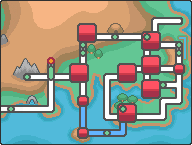
Location of Indigo Plateau in Kanto.
|
|
|
The Indigo Plateau (Japanese: セキエイこうげん Sekiei Plateau) serves as the capital for the Pokémon League in the Kanto region. It is the final destination for Pokémon Trainers collecting Indigo or Johto League Badges. This is where the Trainers who have defeated all of the eight Gym Leaders of either Kanto or Johto battle against the Elite Four and the Pokémon Champion. In the anime, it is the location of the Indigo Plateau Conference, the Kanto Grand Festival, and the Pokémon League Village.
It is located just north of Victory Road and Route 23, and east of Mt. Silver. In the Generation I games, Pokémon FireRed and LeafGreen, and Pokémon: Let's Go, Pikachu! and Let's Go, Eevee!, the only way to reach the Indigo Plateau is by going through Route 23. In the Generation II games and Pokémon HeartGold and SoulSilver, the Indigo Plateau is reached by going through Route 26. In all the games, Trainers must venture through Victory Road, a lengthy cave acting as a final test for Trainers.
The Elite Four must be battled consecutively, with breaks to the Pokémon Center prohibited. Trainers are unable to go back or return to previous rooms. The only way to open the door and progress through each room is to defeat the Elite Four member of that room. Each member of the Elite Four is stronger than the previous member, and like Gym Leaders, each specialize in a different type.
Slogan
The ultimate goal of Trainers!RBYFRLG or The Ultimate Goal for Trainers!GSCHGSS and The highest Pokémon authority! [non-Japanese Generations I and III only] (Japanese, all generations: ポケモン トレーナーの ちょうてん! The Pokémon Trainer's zenith! and ポケモンの さいこう きかん The highest organization on Pokémon).
Geography
Superstructure
In the games, Indigo Plateau is depicted as a large building surrounded by mountainous areas. Indigo Plateau area changes in every generation, however in every generation there is a small area at the entrance that connects the exit of Victory Road to Indigo Plateau.
In Generation I, there is a narrow passageway, where giant statues act as barriers which lead to the entrance.
In Generation II, the area between Victory Road and Indigo Plateau is shorter and wider, and the statues have been removed only to be replaced by trees.
In Generation III, there is a flight of stairs that leads up to Indigo Plateau from Route 23, with a small area outside the entrance with a couple of giant statues.
In Generation IV, the pathway is the same as Generation II, but much fancier. There are two archways each with a small set of stairs above them and Poké Ball statues that appear left and right across the path. The trees on both sides of the path can be Headbutted, but they do not contain any wild Pokémon.
In Generation VII, the exterior is highly similar to how it was in Generation III, with several big statues standing on both sides of a flight of stairs, accompanied by multiple lush trees.
Ground floor
| Generation I
|
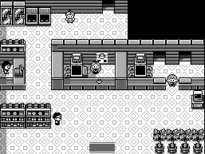
|
|
| Generation II
|
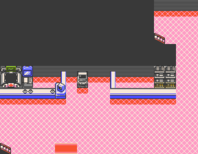
|
|
| Generation III
|
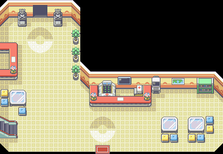
|
|
| Generation IV
|
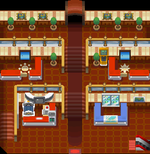
|
|
|
On the ground floor is a combined Poké Mart and Pokémon Center. This is the last safe stop before Trainers make their way up to the upper floors, therefore, Trainers can purchase and stock up on items, as well as heal their Pokémon before leaving. There are a number of things a player can do on this floor. A Pokémon Center Nurse heals all status conditions, recharges HP and PP of all party Pokémon, free of charge. The nurse is located at the main counter just as the player enters Indigo Plateau. It also hosts the Cable Club and the Union Room, which facilitates multiplayer gameplay and link players to battle and trade one another. Trainers also have access to a PC. Trainers can also buy items from the Poké Mart. The Poké Mart stocks rare items that can only be found in Indigo Plateau.
In Generation II, the layout of the ground floor is slightly modified, with the Cable Club and the Union Room relocated upstairs. The PC is now located in the middle of the room, while the nurse is located on the left of it, and the Poké Mart is located on the right of it. There is also an old man standing near the counter that will ask the player if they miss their home, and will use an Abra to Teleport the Trainer back to New Bark Town. He offers this because the Trainer cannot Fly to Johto from the Indigo Plateau. He will disappear after the player defeats the Elite Four and Champion for the first time.
In Generation III, the ground floor is similar to the ground floor in Generation I, however the Cable Club and the Union Room are relocated upstairs. There are a couple of Trainers waiting or resting from training in Victory Road.
In Generation IV, the ground floor is revamped with a regal red motif with stairs in the center covered in red carpet. Like the Pokémon Centers in HeartGold and SoulSilver, the wireless facilities are located in the same room as the nurse, one flight of stairs above. To the right of the nurse is the Poké Mart and the stairs to the Wi-Fi Club. The man with an Abra is still there, but he won't Teleport the player, saying that intimidated Trainers just Fly back home; in HeartGold and SoulSilver, the player can Fly to any Fly destination in either region from outside the building. To the right of the Abra man is a terminal where the player can compare records with other players he or she has contacted wirelessly, similar to the rooms in Jubilife TV.
In Generation VII, the ground floor is a big hall with a mainly golden color scheme, and houses no other features besides the Pokémon Center and the Poké Mart. Like in Generation IV, a red carpet is laid on the floor, stretching from the front door to the entrance to the Elite Four's domain. On the west side of the hall is the Madame Memorial, who can teach a Pokémon any of its level-up moves at the cost of one Heart Scale per taught move. Next to the Poké Mart counter is a Super Nerd, who offers to trade the player an Alolan Exeggutor for a Kantonian Exeggutor as many times as they like. After the player has defeated the Pokémon League, a Poké Maniac appears in the hall, selling the player all the Kanto Pokémon Mega Stones for $30,000 each, excluding the starter and Mewtwo Mega Stones.
Pokémon
| Pokémon
|
Games
|
Location
|
Levels
|
Rate
|
| Special Pokémon
|
|
|
P
|
E
|
|
46
|
Unlimited
|
| A colored background means that the Pokémon can be found in this location in the specified game. A white background with a colored letter means that the Pokémon cannot be found here.
|
Poké Mart
Mega Stone seller
First room
| Generation I
|

|
|
| Generation II
|
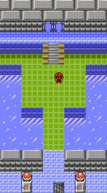
|
|
| Generation III
|
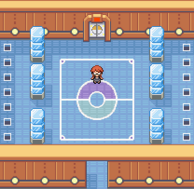
|
|
| Generation IV
|
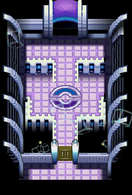
|
|
|
Once Trainers climb the first staircase, they will reach the first room, and upon entering the door will lock so they are unable to return. The door to the second room is also locked and the only way to open the door and progress through each room is to defeat the Elite Four member of that room.
In Generation I, III, and VII, Lorelei is in control of this room, thus is the first member of the Elite Four that must be defeated. Because she uses Ice-type Pokémon, her room is surrounded by ice; however, it is more like water, and in fact behaves exactly like water in Generation I, right down to being able to Surf and catch Pokémon by fishing with the Old and Good Rods. From the entrance, there is a small bridge connected to the batting arena, where Lorelei stands waiting for battle.
In Generation II, the room hasn't actually changed dramatically to custom to Will's design, despite the fact that he trains a completely different type. Ironically, the room's design is encompassed with pools of frozen water on both sides of the battling arena, suiting more of Lorelei's abilities than Will's. There is also a narrow bridge connected to the batting arena where Will stands waiting for battle.
In Generation III, Lorelei's room changes from the icy environment it was to a plain room with six large statues of ice surrounding the battle arena.
In Generation IV, the room is redesigned to accustom to Will's liking. It features a room shaped much like his Generation II room, except with a purple tiled floor. Floating, transparent cubes bob around the room, rising seemingly from a black pit where in Generation II there was ice.
In Generation VII, Lorelei's room now sports an icy blue color scheme, with cold vapor floating in the air and six stylized ice pillars surrounding the battlefield. Lorelei herself is seen sitting on her Lapras, waiting for the next challenger to arrive.
Pokémon
Generation I
| Pokémon
|
Games
|
Location
|
Levels
|
Rate
|
| Fishing
|
|
|
R
|
B
|
Y
|
|
5
|
100%
|
|
|
R
|
B
|
Y
|
|
10
|
50%
|
|
|
R
|
B
|
Y
|
|
10
|
50%
|
| A colored background means that the Pokémon can be found in this location in the specified game. A white background with a colored letter means that the Pokémon cannot be found here.
|
Second room
| Generation I
|
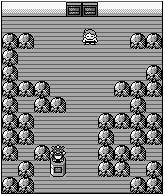
|
|
| Generation II
|
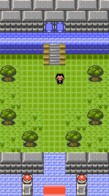
|
|
| Generation III
|
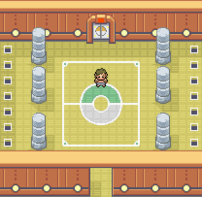
|
|
| Generation IV
|
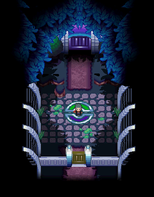
|
|
|
The second room can be accessed after defeating the Elite Four member of the previous room. Like the room before it, the doors to other rooms will lock so Trainers are unable to return or advance forward.
In Generation I, III, and VII, Bruno is the owner of this room, and has designed it according to his Fighting-type specialties. The room is full of giant boulders that surround the battle field, and a Pokémon statue in the corner.
In Generation II, Bruno, the former owner of the room has been replaced by Koga, the former Gym Leader, still using his signature Poison-type Pokémon. The room has been redesigned and customized to meet the needs of his Poison Pokémon, which now has a grassy floor with many trees towering over the area.
In Generation III, Bruno's room changes from the rocky environment it was to a plain room with six large statues of stone surrounding the battle arena.
In Generation IV, Koga once again claims this room. The room is shaped much like his Generation II room. The floor is covered in grass, but this time Koga stands in the middle of a large rectangle of stone. The sides of the room show the shadows of trees. The stone and wall supports are adorned with moss.
In Generation VII, Bruno's room sports a light brown color scheme, with six stylized stone pillars standing around the battlefield. A bright light is shining into the room, shining off the floor and walls.
Third room
| Generation I
|
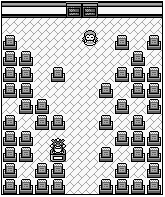
|
|
| Generation II
|
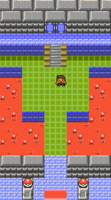
|
|
| Generation III
|
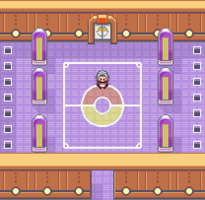
|
|
| Generation IV
|
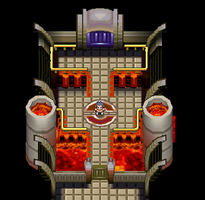
|
|
|
The third room can be accessed after defeating the Elite Four member of the previous room. Like the room before it, the doors to other rooms will lock so Trainers are unable to return or advance forward.
In Generation I, III, and VII, Agatha is the owner of this room, and has designed it according to her own Ghost-type specialties. The room is full of giant gravestones that surround the battle field. There are gravestones on both side of the battling arena, and a Pokémon statue in the bottom left hand corner.
In Generation II, Agatha, the former owner of the room has been replaced by Bruno, the former owner of the second room, who has been promoted and has now taken her place, still using his signature Fighting-type Pokémon. The room has been redesigned and customized now with pools of lava bubbling left and right of the battle arena. There is a narrow bridge connected to the battling arena where Bruno stands waiting for battle.
In Generation III, Agatha's room changes from the eerie environment with gravestones to a plain room with six large statues surrounding the battle arena.
In Generation IV, Bruno has this room, and it once again is roughly the shape of his Generation II room. The pit is once again filled with lava, but two large tubs line the side of the room, giving it a refinery feel.
In Generation VII, Agatha's room has a dark color scheme, with moss growing in between the purple floor tiles. The battlefield is surrounded by six dark, stylized pillars, each of them housing what seems like a will-o'-the-wisp, giving off an eerie blue light.
Fourth room
| Generation I
|
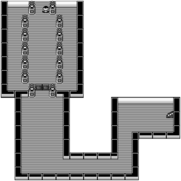
|
|
| Generation II
|
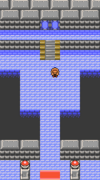
|
|
| Generation III
|
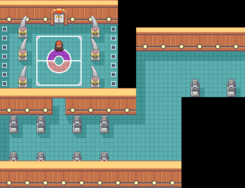
|
|
| Generation IV
|
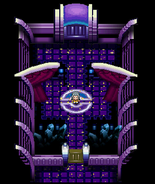
|
|
|
The fourth room can be accessed after defeating the Elite Four member of the previous room. However, unlike the previous rooms before it, once a Trainer advances through the doors to the fourth room, they will automatically travel through the room to face off with the final Elite Four member. As such, it would be wise for Trainers to prepare for the final Elite Four member before they enter the fourth room. This will only happen in Generation I and III, however. In Generation II and IV, the Trainer will advance to the fourth room normally.
In Generation I and III, the room enters in a long, narrow pathway that curves around in a sideways 'S' shape. The pathway will end in with a battle arena where Lance will be standing. There are many Pokémon statues surrounding the battle arena, but these are moved to the pathway in Generation III, and the main battle arena is surrounded by six large fang-shaped statues.
In Generation II, Karen is the current owner of the fourth room, and it is like any other room within the Elite Four. The room has been redesigned and customized now with a deep, dark pit left and right of the battle arena. There is a narrow bridge connected to the batting arena where Karen stands waiting for battle.
In Generation IV, Karen has this room again. The room is shaped like her old Generation II room. The pit, however, is now filled with blue crystals. The floor is purple with a star pattern and stage curtains are hung behind Karen, corresponding with the movie star look of Karen in this generation.
In Generation VII, although the room is once again housed by Lance, there is no pathway leading up to it, unlike in the previous games where he owns the room. The room has turquoise floor tiles and golden walls. The six pillars standing around the battlefield have a dragon scale pattern on them and four declarations shaped like a dragon's fang at each of their base. Lance, who is waiting for new challengers at the end of the room, is accompanied by his Dragonite standing next to him.
Champion's room
| Generation I
|
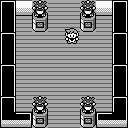
|
|
Generation II
(Gold/Silver)
|

|
|
Generation II
(Crystal)
|

|
|
| Generation III
|
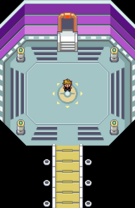
|
|
| Generation IV
|
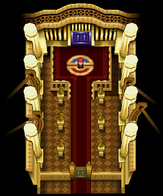
|
|
|
Once a Trainer defeats the final member of the Elite Four, they will go on to the Champion's room. The current Champion awaits in his room for the final battle to unfold. Like the previous four rooms, the Champion's room will automatically direct the Trainer to the Champion.
In Generations I, III, and VII, the Champion is BlueRBYFRLG/TracePE, who had become the Champion just recently. The battlefield is a small room, with two entrances; one that leads from the fourth room, the other leads to the Hall of Fame.
In Generation II and IV, the Champion is Lance, formerly the fourth Elite Four member, who continues to use Dragon-type Pokémon. The room has a long hall decorated with Dratini statues (regular statues in Gold and Silver) left and right of the path. At the end of the hall, the player reaches an elevated part of the room where Lance awaits. Behind him are double doors that lead to the Hall of Fame. In Generation IV, this room is gold colored, with a red carpet going down the middle and moving gears on the walls.
Hall of Fame
- Main article: Hall of Fame
Once the Champion is defeated, there is a great congratulations and the victor will be recorded in the Hall of Fame and made current Champion. The Hall of Fame is a record kept by the Pokémon League of all the Pokémon Trainers who have ever defeated the Pokémon League. In the hallway to the Hall of Fame recording room, Professor Oak is present to congratulate the player. It is a fairly large room that only contains a large computer. The Hall of Fame will record the Trainer's ID number, name, and party. For each Pokémon of the player's party, the species, name, gender, level, and area met are recorded; the gender is not recorded prior to Generation II and the area met is not recorded prior to Generation III.
After becoming Champion, the player returns home, rather than staying at the Pokémon League to fight challengers. Prior to Generation VII, the previous Champion keeps his position. In Let's Go, Pikachu! and Let's Go, Eevee!, however, the player keeps the title of Champion, and Trace challenges them to retake his title at the end of the gauntlet.
Elite Four and Champion
Generation I
- Main article: Indigo Plateau/Generation I
Generation II
- Main article: Indigo Plateau/Generation II
Generation III
- Main article: Indigo Plateau/Generation III
Generation IV
- Main article: Indigo Plateau/Generation IV
Generation VII
First battles
Lorelei
Bruno
Agatha
Lance

|
|
Reward: $11,000
|
|
|
|
|
|
Trace
 In Let's Go, Pikachu!:
In Let's Go, Pikachu!:

|
|
Reward: $13,680
|
|
|
|
|
|
 In Let's Go, Eevee!:
In Let's Go, Eevee!:

|
|
Reward: $13,680
|
|
|
|
|
|
Lorelei
Bruno
Agatha
Lance

|
|
Reward: $13,000
|
|
|
|
|
|
Trace
 In Let's Go, Pikachu!:
In Let's Go, Pikachu!:

|
|
Reward: $18,760
|
|
|
|
|
|
 In Let's Go, Eevee!:
In Let's Go, Eevee!:

|
|
Reward: $18,760
|
|
|
|
|
|
Items
Trainers
In Generation II and IV, Silver can be battled here on Mondays and Wednesdays following the battle against him at Mt. Moon (as well as the Multi Battle against Lance and Clair in the Dragon's Den in Generation IV). Silver will appear to halt the player for a battle as they walk towards the steps to enter the Elite Four's domain.
In Generation VII, the player can fight Red outside the Pokémon League building if they have defeated at least six Master Trainers and have six Pokémon in their party. Like during all Master Trainer battles, the player isn't allowed to use items from their Bag during this battle. After being defeated, Red will grant the player the title of Battle Master before leaving, though he will reappear for a rematch each time the player defeats the Elite Four.
Generation II
 If the player chose Chikorita:
If the player chose Chikorita:

|
|
Reward: $5000
|
|
|
|
|
|
 If the player chose Cyndaquil:
If the player chose Cyndaquil:

|
|
Reward: $5000
|
|
|
|
|
|
 If the player chose Totodile:
If the player chose Totodile:

|
|
Reward: $5000
|
|
|
|
|
|
Generation IV
 If the player chose Chikorita:
If the player chose Chikorita:

|
|
Reward: $3840
|
|
|
|
|
|
 If the player chose Cyndaquil:
If the player chose Cyndaquil:

|
|
Reward: $3840
|
|
|
|
|
|
 If the player chose Totodile:
If the player chose Totodile:

|
|
Reward: $3840
|
|
|
|
|
|
Generation VII

|
|
Reward: N/A
|
|
|
|
|
|
In the side series
In Pokémon Pinball
In Pokémon Pinball, Indigo Plateau appears on the Red and Blue tables; catchable Pokémon include Spearow, Sandshrew, Machop, Geodude, Onix, Pinsir, Ditto, Moltres, Mewtwo, and Mew.
In the Pokémon Stadium series
- Main article: Indigo Plateau/Stadium series
Fields based on those of the Indigo Plateau appear in Pokémon Stadium's Gym Leader Castle and Pokémon Stadium 2's Johto Gym Leader Castle. Just like in the core series games, the player has to defeat all the Elite Four members in order to reach the Champion. In the Pokémon Stadium series games, after defeating the Champion and entering the Hall of Fame, the player earns a special reward.
In Pokémon Stadium
In Pokémon Stadium, clearing Indigo Plateau earns the player a random gift Pokémon from eight different possibilities: Bulbasaur, Charmander, Squirtle, Hitmonlee, Hitmonchan, Eevee, Omanyte, or Kabuto.
When the Rival is beaten in Round 1, the prize Pokémon will be holding a Normal Box if traded to Generation II, which contains a Silver Trophy. When the Rival is beaten in Round 2, the prize Pokémon will be holding a Gorgeous Box, which contains a Gold Trophy.
In Pokémon Stadium 2
In Pokémon Stadium 2, as a reward for clearing Indigo Plateau, the player unlocks a new mode for the Game Boy Tower. Clearing Round 1 unlocks either a Doduo Sticker mode (if not all Stadium Cups have been beaten) or a Dodrio Sticker mode (if all Stadium Cups have been beaten) in Game Boy Tower for the Generation I games; clearing Round 2 unlocks the same mode, but for the Generation II games. Additionally, the player is given the opportunity to reteach a Pokémon in their current party a move it has forgotten. Furthermore, the player will be granted access to the Kanto Gym Leader Castle.
In the anime

Indigo Plateau in the
animeIn the main series
Indigo Plateau first appeared at the end of Bad to the Bone, after Ash and his friends left for the Indigo Plateau Conference. In the following episode, Ash and the others helped to run the flame of Moltres to Indigo Stadium, and they officially reached Indigo Plateau. They stayed there until the end of the tournament in Friends to the End.
Indigo Plateau is also the home of Pokémon League Village, where Ash, his friends, and all the other Trainers stayed during the events of the League.
It is also the location of the Kanto Grand Festival, which took place between May, We Harley Drew'd Ya! and Channeling the Battle Zone!. May and her rivals Drew, Harley, and Solidad joined the competition along with several other Coordinators who successfully collected five Contest Ribbons from the Kanto region. 270 contestants competed in the preliminary Appeals Round, which was held in two separate stadiums, but only 64 advanced to the main competition. In the end, Solidad emerged victorious, earning the Ribbon Cup and the title of Top Coordinator.
To attend all of the Trainers who come to participate in these events, the local Pokémon Center is larger than most others in the region. It accommodates the Coordinators taking part in the Kanto Grand Festival and it has a dining hall where the party to mark the end of the competition is held.
One of the locations of the Battle Pyramid also stands nearby.
In Pokémon Origins
Red arrived at Indigo Plateau in File 4: Charizard, where he challenged and defeated the Elite Four. Once he had defeated Lance, he found out that he still had to battle the Champion, who turned out to be his rival, Blue. After a hard-fought battle, Red emerged victorious, making him the new Champion and worthy of entering the Hall of Fame.
The battle arenas at the Indigo Plateau seem to have self-repairing systems, automatically fixing any possible damage caused to the arenas during battles.
In Pokémon Generations
Indigo Plateau first appeared in The Challenger, where Blue challenged and defeated the Elite Four. After claiming the title of Champion, Red arrived to challenge him.
Indigo Plateau reappeared in The Legacy, where Looker and Silver were seen talking about Giovanni outside of the Pokémon League building. After they had finished talking, Silver started walking towards the building, intending to challenge the Elite Four.
In the manga

Indigo Plateau in Pokémon Adventures

Indigo Plateau in The Electric Tale of Pikachu

Indigo Plateau in Pokémon Zensho
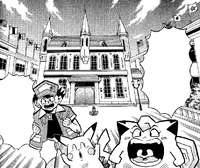
Indigo Plateau in Pokémon Pocket Monsters
In The Electric Tale of Pikachu manga
Like in the anime, the Indigo Plateau Conference was held at the Indigo Plateau in The Electric Tale of Pikachu, taking place in Welcome to the Big Leagues and The Indigo Finals. Although the manga was based on the anime, there were still several notable differences between the two, such as Brock and Misty entering the conference as well, and Gary being defeated by Ritchie instead of Melissa.
In the Pokémon Adventures manga
At the end of this chapter, Red traveled to the Indigo Plateau to take part in the triennial Indigo League Tournament. Blue, Green, and Dr. O also participated in the tournament, and made it to the semi-finals along with Red. In the first semi-final battle, Green was defeated by Dr. O, who turned out to be Professor Oak. After Professor Oak withdrew from the competition, Red and Blue's semi-final battle was changed into the final battle of the tournament. Red eventually won the battle, making him the Pokémon League Champion.
The Indigo Plateau hosted a tournament between the Gym Leaders of Johto and Kanto in order to reveal the identity of the Masked Man. For the event, the Magnet Train line was changed to travel through the Pokémon League. The tournament was interrupted when Neo Team Rocket and the Masked Man attacked the stadium, but the final battle of the tournament, Blaine vs. Clair, was conducted aboard the Magnet Train during the fight against the Neo Team Rocket Grunts, ending in Blaine's victory and thus resulting in Kanto winning the tournament. Although Neo Team Rocket was taken down, the incident prevented the actual Indigo League Tournament from being conducted.
In the Pokémon Pocket Monsters manga
Red arrived at the Indigo Plateau in To the Pokémon League!! in order to challenge the Elite Four.
In the Pokémon Zensho manga
Satoshi went to the Indigo Plateau in Indigo Plateau to challenge the Elite Four. After defeating the Elite Four, he found out that his rival, Shigeru, had already done that before him, having claimed the title of Pokémon League Champion for himself. After a tough battle between Satoshi's Charizard and Shigeru's Blastoise, Satoshi finally emerged victorious, making him the new Pokémon League Champion.
In the TCG
The following is a list of cards named Indigo Plateau.
Trivia
- Indigo Plateau and Route 26 are the only places that can be flown to from both Kanto and Johto in Pokémon HeartGold and SoulSilver.
- In the Generation I games, due to an oversight, wild Pokémon can be found by fishing in Lorelei's room.
- In Pokémon FireRed and LeafGreen, it is possible to rematch the original Elite Four and Champion teams. This requires failing to meet the two criteria for acquiring the National Pokédex. Once the player has been given the National Pokédex, the Elite Four challenge closes until the Sevii Islands quest is completed.
- The removal of Route 23 in Pokémon HeartGold and SoulSilver caused Indigo Plateau to be moved significantly southward on the Pokégear's map when compared to the Town Map in Pokémon FireRed and LeafGreen, where it was located to the northwest of Pewter City; in HeartGold and SoulSilver, the Indigo Plateau is to the southwest of Pewter City.
- In Generations I and III, Indigo Plateau is the only Pokémon League where the different Elite Four rooms have different background music. Lorelei, Bruno, and Agatha's room share their background music with Gyms, the Rocket Hideout, and Pokémon Tower, respectively, while Lance's room uses the same background music as the rest of Indigo Plateau.
- In Generation III, the lobby also uses the Gym theme. In every other generation, it uses the Indigo Plateau theme.
- The first Elite Four member here always uses a Jynx, and if the post-National Pokédex rematch from FireRed and LeafGreen is excluded, the same also applies to Slowbro.
- Indigo Plateau makes an appearance as a backdrop when a Pokémon from Kanto is used in the Alola Photo Club in Pokémon Ultra Sun and Ultra Moon.
Name origin
| Language
|
Name
|
Origin
|
| Japanese
|
セキエイこうげん
Sekiei Kōgen
|
From 石英 sekiei (quartz)
|
| English, German
|
Indigo Plateau
|
From indigo (a blue-purple color), one of the seven traditional colors of the rainbow. It is named after the dye produced from he indigo plant, following both the theme naming of settlements in Kanto (colors) and Johto (plants).
|
| French
|
Plateau Indigo
|
From its English name
|
| Italian
|
Altopiano Blu
|
From blu (blue)
|
| Spanish
|
Meseta Añil
Planicies Indigo*
|
From añil (indigo)
From its English name
|
| Korean
|
석영고원
Seokyeong Gowon
|
From its Japanese name
|
| Chinese
|
石英高原
Shíyīng Gāoyuán / Sehkyīng Gōuyùhn
|
From its Japanese name
|
| Polish
|
Błękitne Wzgórze*
Miasto Indigo*
Płaskowyż Indygo*
|
Literally "Sky Blue Hill"
Literally "Indigo City"
From its English name
|
| Brazilian Portuguese
|
Platô Índigo*
Planalto Índigo*
Planalto Indigo*
|
From English name
|
| Russian
|
Плато Индиго Plato Indigo
Хумбленес Humblenes*
|
From English name
|
| Finnish
|
Indigo-ylänkö*
|
From English name
|
| Swedish
|
Indigoplatån
|
From English name
|
| Vietnamese
|
Cao nguyên Sekiei
|
Transliteration of the Japanese name.
|

 In Let's Go, Eevee!:
In Let's Go, Eevee!:
 In Let's Go, Eevee!:
In Let's Go, Eevee!:
 If the player chose Chikorita:
If the player chose Chikorita:
 If the player chose Cyndaquil:
If the player chose Cyndaquil:
 If the player chose Chikorita:
If the player chose Chikorita:
 If the player chose Cyndaquil:
If the player chose Cyndaquil:

